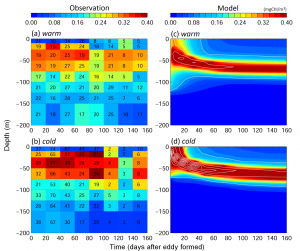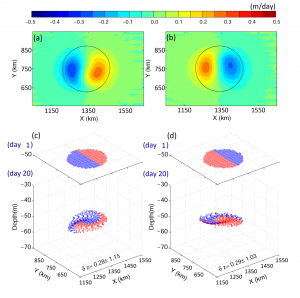by Yu-Lin Chang[1][2],
in collaboration with Yasumasa Miyazawa[3], Lie-Yauw Oey[4], Tsubasa Kodaira[5], Shihming Huang[4]
In this study[6], we investigate the processes of phytoplankton growth and decline in mesoscale eddies in the western North Pacific Ocean based on the in-situ chlorophyll data obtained from 52 cruises conducted by the Japan Meteorological Agency together with idealized numerical simulations. Both the observation and model results suggest that chlorophyll/phytoplankton concentrations are higher in cold than in warm eddies in near-surface water (z > -70 m) (Fig. 1). In the idealized simulation, the isopycnal movements associated with upwelling/downwelling transport biomass to different vertical depths during eddy formation (stage A). Biomass in cold eddies is transported toward shallower waters while those in warm eddies move toward deeper waters. In the period after the eddy has formed (stage B), sunlight and initially upwelled nutrients together promote the growth of phytoplankton in cold eddies. Phytoplankton in warm eddies decays due to insufficient sunlight in deeper waters.

In stage B, upwelling and downwelling coexist in both warm and cold eddies, contributing nearly equally to vertical displacement (Fig. 2). The upwelling/downwelling-induced nitrate flux accounts for a small percentage (~3%) of the total nitrate flux in stage B. The vertical velocity caused by propagating eddies, therefore, is not the primary factor causing differences in phytoplankton concentrations between stage-B warm and cold eddies.

- [1] Institute of Marine Environmental Sciences and Technology, National Taiwan Normal University↩
- [2] Update Aug 1, 2017: Dr. Chang Joined JAMSTEC from Aug 1, 2017. ↩
- [3] Application Laboratory, Japan Agency for Marine-Earth Science and Technology↩
- [4] Graduate Institute of Hydrological and Oceanic Sciences, National Central University↩
- [5] Department of Ocean Technology, Policy, and Environment, Graduate School of Frontier Sciences, The University of Tokyo↩
- [6] Chang Y-L, Miyazawa Y, Oey L-Y, Kodaira T, Huang S (2017) The formation processes of phytoplankton growth and decline in mesoscale eddies in the western North Pacific Ocean J Geophys Res: Oceans doi:10.1002/2017jc012722↩
